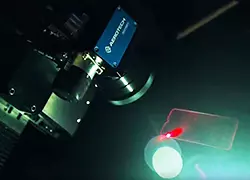What Is the Manufacturing Process of Laser Cutting? | Steps & Limitations
What is the manufacturing process of laser cutting? The manufacturing process of laser cutting is a highly advanced method that uses a focused beam...
Work with our team to determine which products or systems are the best fit for your application.
Some Aerotech products are available for immediate order in North America through our partner Motion Plus.

A case study examining display production that optimizes quality and throughput – and lower total cost.
2 min read
 Bryan Germann
Jun 30, 2025 2:29:53 PM
Bryan Germann
Jun 30, 2025 2:29:53 PM
Laser processing is a sophisticated manufacturing technique that uses a focused beam of light to precisely alter materials. It works on a simple yet powerful principle: the conversion of light energy into highly concentrated heat. This thermal energy allows the laser to cut, weld, drill or mark a vast range of materials with a level of precision that is often unattainable with conventional methods.
The entire process is a symphony of controlled energy and motion. Understanding how these elements come together makes it easy to see why this technology is a cornerstone of modern, high-precision manufacturing.
Precision laser material processing refers to any manufacturing process that uses a laser to achieve a desired physical change in a workpiece. The laser beam acts as a non-contact tool, delivering energy to a very small spot with immense power density. The question of what is the laser processing method used for can be answered broadly: it is used for cutting, joining and surface modification. This includes specific tasks like drilling microscopic holes in aerospace components, welding hermetic seals on medical implants and cutting intricate patterns in electronic circuits. The core idea is to use light to perform tasks that would otherwise require a physical tool.
Laser material processing refers to any manufacturing process that uses a laser to achieve a desired physical change in a workpiece.
The meaning of laser processing lies in its unique combination of precision, flexibility and non-contact interaction. Because the "tool" is a beam of light, it doesn’t wear down, and it doesn't exert mechanical force on the part, which is ideal for processing delicate or brittle materials without causing damage. The laser processing technology is highly controllable; by adjusting parameters like power, speed and focus, a single machine can be tuned to perform different tasks on different materials. This software-driven flexibility makes it a powerful tool for rapid prototyping, custom manufacturing and high-volume automated production.
A laser processing machine is an integrated system that combines several key components to perform a laser-based manufacturing task. A typical machine includes:
Laser Source: This is the "engine" that generates the high-energy beam of light (e.g., a fiber, CO₂ or ultrafast laser).
Beam Delivery System: A series of mirrors, lenses or fiber optic cables that guide the laser beam from the source to the workpiece.
Focusing Optics: A lens assembly, often housed in a processing head, that focuses the laser beam to a very small, high-energy spot.
Motion Control System: This is the "brain and muscle" of the machine. It includes CNC (Computer Numerical Control) controllers, drives and mechanical stages or galvo scanners that precisely move the workpiece or the laser beam along a programmed path.
Assist Gas System: A system that delivers a jet of gas (like oxygen or nitrogen) to the processing zone to help remove molten material and enhance the process.
The laser processing of materials describes the physical interaction between the laser beam and the workpiece. When the focused laser beam strikes the material, its energy is absorbed, causing an extremely rapid and localized temperature increase. This thermal interaction can result in three primary outcomes:
Heating: At lower power densities, the laser heats the surface without melting it, which is used for processes like surface hardening or annealing.
Melting: At higher power densities, the material reaches its melting point. This is the mechanism behind laser welding, where molten material from two components is fused together.
Vaporization: At the highest power densities, the material is heated so quickly that it boils and turns into a vapor. This rapid material removal is the basis for laser cutting, drilling and engraving.
The final result is determined by a precise balance of laser power, traverse speed and the material's unique thermal and optical properties.
What is the manufacturing process of laser cutting? The manufacturing process of laser cutting is a highly advanced method that uses a focused beam...
What Is a Galvo Laser Used For? A galvo laser scan head is a powerful and versatile tool used across a wide range of high-precision manufacturing...
What are the applications of laser cutting? Laser cutting is one of the most versatile and widely adopted technologies in modern manufacturing,...